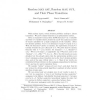Free Online Productivity Tools
i2Speak
i2Symbol
i2OCR
iTex2Img
iWeb2Print
iWeb2Shot
i2Type
iPdf2Split
iPdf2Merge
i2Bopomofo
i2Arabic
i2Style
i2Image
i2PDF
iLatex2Rtf
Sci2ools
66
Voted
SODA
2003
ACM
2003
ACM
Random MAX SAT, random MAX CUT, and their phase transitions
With random inputs, certain decision problems undergo a “phase transition”. We prove similar behavior in an optimization context. Given a conjunctive normal form (CNF) formula F on n variables and with m k-variable clauses, denote by max F the maximum number of clauses satisfiable by a single assignment of the variables. (Thus the decision problem k-sat is to determine if max F is equal to m.) With the formula F chosen at random, the expectation of max F is trivially bounded by 3 4 m E max F m. We prove that for random formulas with m = cn clauses: for constants c < 1, E max F is cn − Θ(1/n); for large c, it approaches (3 4 c + Θ( √ c))n; and in the “window” c = 1 + Θ(n−1/3 ), it is cn − Θ(1). Our full results are more detailed, but this already shows that the optimization problem max 2-sat undergoes a phase transition just as the 2-sat decision problem
Related Content
| Added | 01 Nov 2010 |
| Updated | 01 Nov 2010 |
| Type | Conference |
| Year | 2003 |
| Where | SODA |
| Authors | Don Coppersmith, David Gamarnik, Mohammad Taghi Hajiaghayi, Gregory B. Sorkin |
Comments (0)

